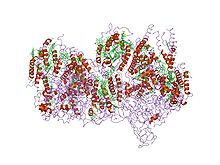Cytochrome b559
This article may be too technical for most readers to understand. (May 2016) |
| Cytochrome b559, alpha (gene psbE) and beta (gene psbF)subunits | |||||||||
|---|---|---|---|---|---|---|---|---|---|
 Structure of Photosystem II from Thermosynechococcus elongatus.[1] | |||||||||
| Identifiers | |||||||||
| Symbol | Cytochrom_B559 | ||||||||
| Pfam | PF00283 | ||||||||
| InterPro | IPR013081 | ||||||||
| PROSITE | PDOC00464 | ||||||||
| OPM superfamily | 2 | ||||||||
| OPM protein | 2axt | ||||||||
| |||||||||
| Lumenal portion of Cytochrome b559, alpha (gene psbE) subunit | |||||||||
|---|---|---|---|---|---|---|---|---|---|
 Structure of oxygen-evolving photosystem II from Thermosynechococcus vulcanus.[2] | |||||||||
| Identifiers | |||||||||
| Symbol | Cytochrom_B559a | ||||||||
| Pfam | PF00284 | ||||||||
| InterPro | IPR013082 | ||||||||
| PROSITE | PDOC00464 | ||||||||
| OPM superfamily | 2 | ||||||||
| OPM protein | 2axt | ||||||||
| |||||||||
Cytochrome b559 is an important component of
This domain occurs in both the alpha and beta subunits of cytochrome B559. In the alpha subunit, it occurs together with a lumenal domain (InterPro: IPR013082), while in the beta subunit it occurs on its own.
Cytochrome b559 can exist in three forms, each with a characteristic redox potential. These forms are very low potential (VLP), ≤ zero mV; low potential (LP) at 60 mV; and high potential (HP) at 370 mV. There is also an intermediate potential (IP) form that has a redox potential at pH 6.5-7.0 that ranges from 170 to 240 mV. In oxygen-evolving reaction centers, more than half of the cyt b559 is in the HP form. In manganese-depleted non-oxygen evolving photosystem II reaction centers, cyt b559 is usually in the LP form.[7]
